Background
Consumption demands on naturally occurring materials and energy sources in the world today are viewed to be critical factors and driving forces behind the concept of sustainability in the architectural world. The concept focuses on unique properties of reusability and recyclability of these resources with minimal impact on the environment. That has compelled home owners and architects to rethink the whole concept of sustainability in line with sustainable green buildings with associated benefits. So the need to incorporate every aspect of the principles of sustainability in the building industry and associated variables has compelled the integration of the technology on a wider scale in their design and construction.
Rationale
The rationale behind the research is to identify, analyze, and equip home owners and architects with the broad knowledge of the economic benefits and environmental benefits at macro and micro levels while remaining focused on current trends in energy demands and consumption in the world today. These are drivers justifying the need to go green in the building industry.
Introduction
Resource use is an important aspect in the technological world today. The call for an imperative use of resource efficient methods for the construction of buildings has come at a time when demands on available resources are increasing as the world population experiences an exponential rise. That has had an impact on the approaches building owners and architects use in the design and construction in the building industry. Therefore, ethical and technical approaches to resource utilization, sustainability, productivity, and health are fundamental elements in the construction industry today. The need to optimize these variables while integrating economic realities for sustainable buildings from the design, pre-design, site considerations, material specifications, the design process, and maintenance for sustainability are core principles to perpetuate sustainability.
Literature Review
Economics and the environment
The exponential rise in demands on sustainable use of environmental resources in all aspects across a number of industries places demands for designs that are economically feasible in meeting long term human needs (Hart, 1). To that end, the concept of sustainability particularly in the building industry calls for construction practices that emphasize on the benefits that come with sustainable designs and constructions. Therefore, the economic efficiency of these buildings spans water efficiency, energy efficiency, material conservation, waste reduction efficiency, construction efficiency, building value, productivity and occupational health, insurance liability, and locally available economic opportunities. The concept of a sustainable green building is illustrated in the diagram below (Allan & Philippacopoulos, 5).
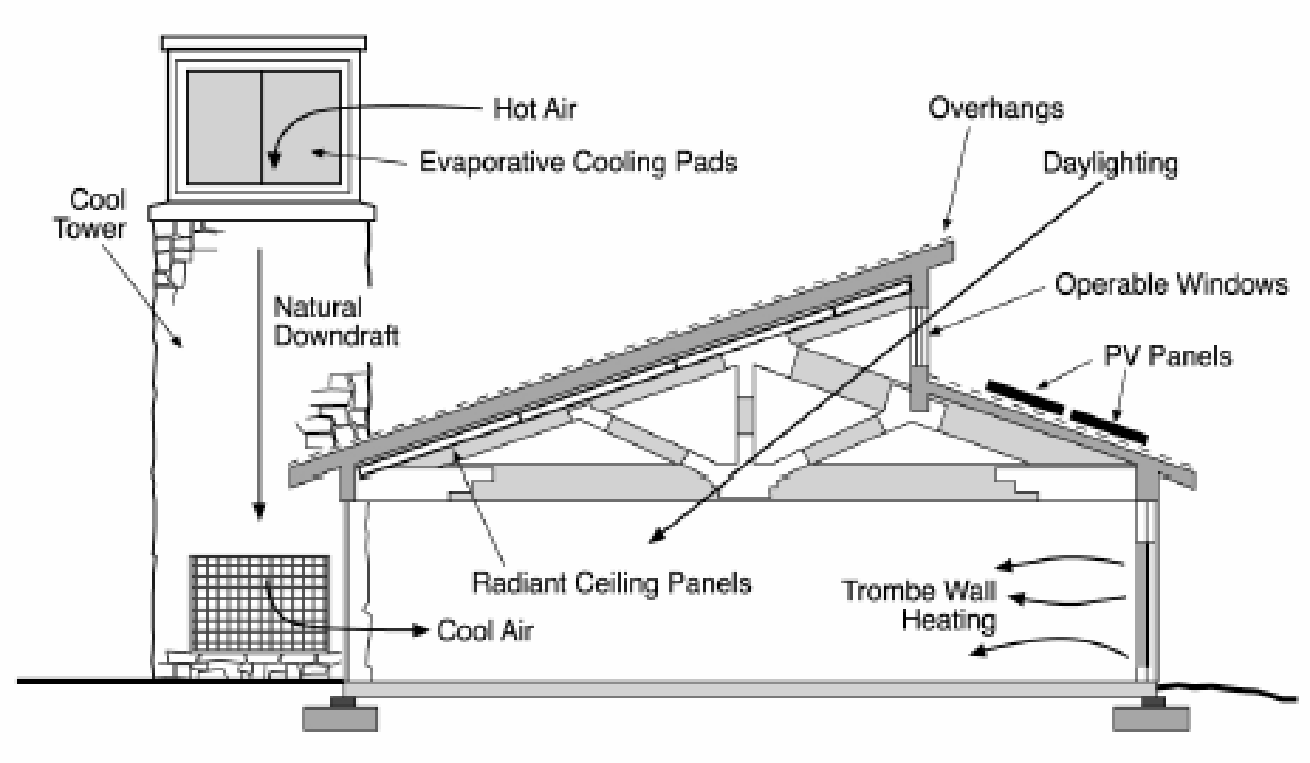

The ambient supply of air into the green building variably affects the internal quality of the microclimate as demonstrated above.
Water efficiency accounts for sustainable decrease in water consumption optimized by an efficient and sustainable design. The design layout optimizes water consumption through water efficient fixtures and appliances. In addition to that, the concept of sustainability inculcates behavioral changes that lead to reduced water consumption yielding a desirable payback to sustainably reduce the rate of water consumption. Thus, the economic impact on ever increasing demands for water as a variable of rising urban population leads to water efficiency and proportionate pressure on water resources (Bolin, 1).
A critical analysis of an optimal design indicates that sustainable green buildings do not incorporate water urinals as a water saving economic measure. In comparison with traditional piping systems, sustainable green buildings optimize the use of piping systems by minimizing the number of piping systems that demand minimal amounts of water.
On the other hand, optimal use of energy is another economic benefit realized from the principles of sustainability. Statistically, the amount of energy used to improve the internal climate of buildings accounts for over 50% of energy usage in buildings. Energy bills are driven by demands on the cooling, heating, and lighting systems in buildings (Filippakopoulos & Berndt, 56). However, when climate tailored technologies are used in the design and implementation processes, returns on investment are optimal compared to the traditional approaches in maintaining the in-house climate. The principles of sustainable design incorporate efficient use of other resources, effective life cycle designs, and designs that reflect the human element. In addition tot that, it is worth noting that location dependence significantly influences the impact of energy consumption on the environment, leading to direct and indirect cost savings.
Kirk and Dell’Isola emphasize that energy savings are accomplished by designs that optimize on material savings. The influx of building materials, wastes generated from construction sites, inflow of consumer products to meet human needs, and materials consumed in the construction and maintenance are variables that are significantly minimized thorough the adaption of sustainable buildings (22). These design approaches minimize on architectural overdesigns, eliminate unnecessary features incorporated in a building at the finishing stage, significantly reducing project size and cost while focusing on the use of recycled and renovated materials for economic sustainability. To effectively integrate varied aspects of energy efficiency, system design principles are critically focused on as envelope measures. These measures span window distributions for optimal solar exploitation and other forms of energy savings. Integrating a white roof to a design by incorporating additional insulations optimizes energy savings and reduces unnecessary escape. That is in addition to the use of energy efficient outlets and inlets such as windows and doors. Another energy efficient strategy is to incorporate energy efficient mechanical systems such as efficient water heaters, air conditioners, and low pressure ducts. A graphical presentation of annual estimates of energy savings from measures outlined above is shown below.
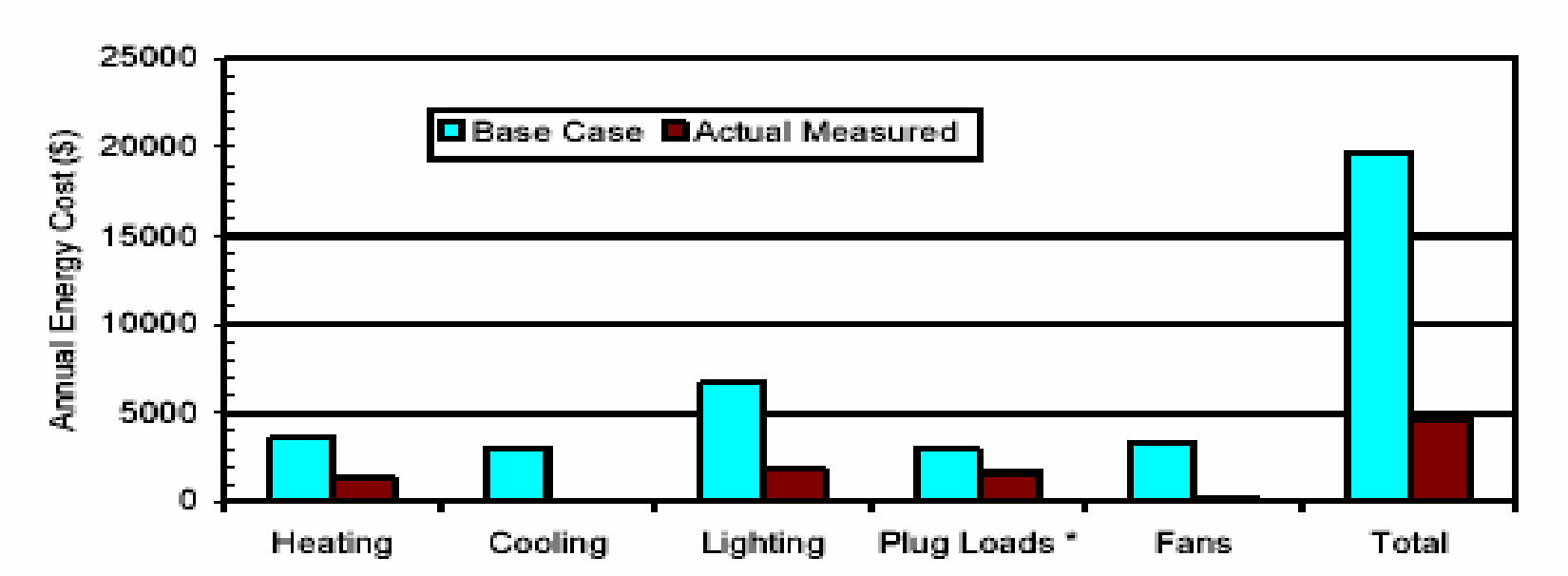
Sustainable green buildings have superior performance ratings compared to traditional buildings. The inherent value and benefits of Sustainable green buildings is best illustrated in the following figures.
Source: Example from David Gottfried
An additional benefit to home owners is the possibility to charge higher rental rates to attract more revenue returns on investments.
Design issues
Sustainable design plays a fundamental role in determining the economy of resources in the design and implementation of a sustainable green building. Thus a sustainable architecture benefits the whole system through significant reductions in the input methods and inflow of non renewable resources while appreciating the flow of renewable resources, incorporating optimum management techniques for outputs and directly minimizing the impact of wastes to the environment through a variety of methods. Worth noting among these techniques for resource optimization are the integration of such technologies as energy, water, and material conservation architects (U.S. Department of Energy, 5).
Pre-design issues call for benchmarked guidelines that factor energy efficiency and usage, minimized strategies for water usage, environmental conservation and impacts from the building, methods of transporting construction materials into and out of the construction site, and projections on energy consumption within the building and in the construction process. To effectively achieve excellent indoor quality, improve the expected life of a building, appreciate the percentage of recyclables inflows and outflows, and minimize aggregate energy effectively achieve the goals of sustainable design and development (Vickers, 2).
In addition to that, resource use should efficiently reflect a balance between inflow and outflow and reflect a balance between human consumption and replacement in the construction cycle. Wastes should be recycled and incorporated into the construction process to minimize their effects particularly on the environment and limit their disposal. On site resources such as wind, solar, and water should be incorporated in the construction process to encourage efficient usage and reuse. In addition to that, the design should reflect efficient usage of space, occupancy, health, excellent indoor quality, optimal employee communication, and limit the use of water as a scarce resource (Horman, 1).
Site design focuses on the architecture of the landscape, operational efficiency of the buildings to be erected on site, prescriptive sound planning methods, the geology of the site, and the cultural significance of the site when erecting a structure (Guillette,1). A site analysis is an effective component for achieving a sustainable green building goal as illustrated below.
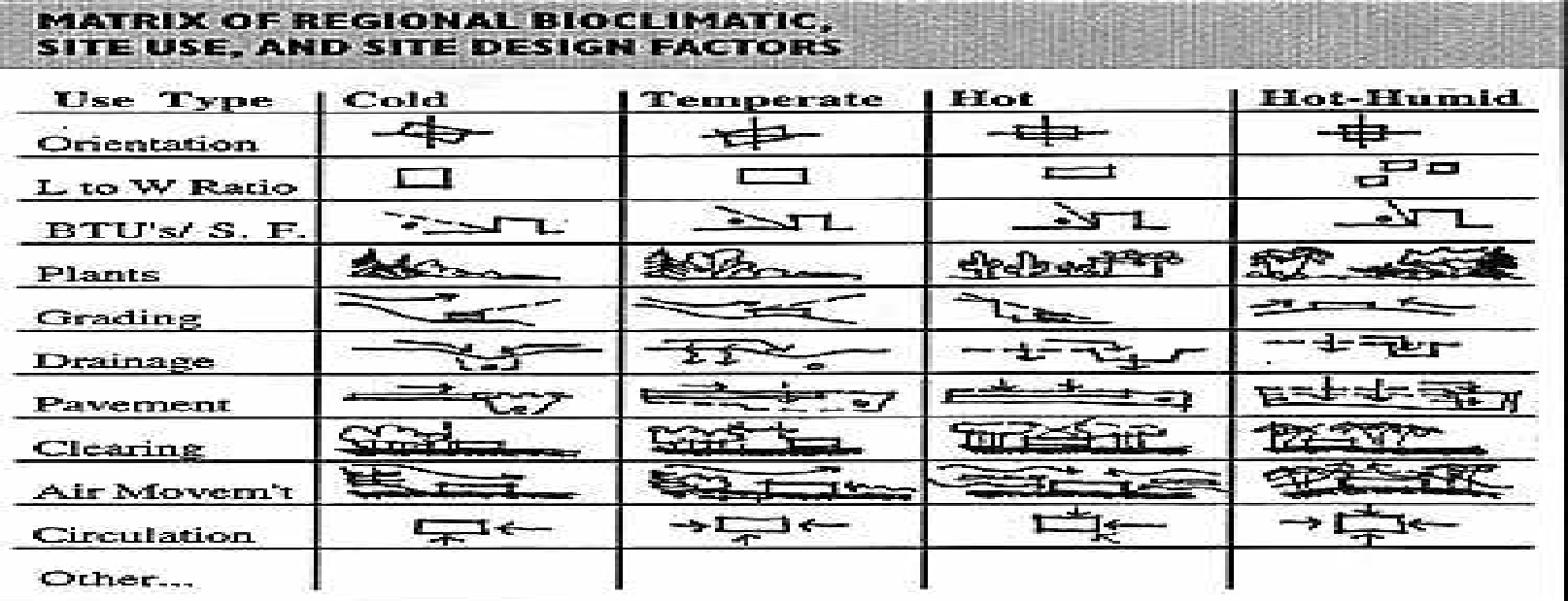
Each design should be analyzed and evaluated against a benchmarked checklist characterizing a responsible design that incorporates environmental considerations as key in the design (Alexander, Ishikawa & Silverstein, 3).
One such factors is emphasis on an efficient design specifically defined by resource efficiency in its construction, integrating high energy efficiency materials in the design and construction of the green building, optimal use of materials and discouraging wastes in the construction process, ensuring system efficiency for occupants in recycling wastes, integration of gray water harvesting mechanisms into the design, and a design that has a potential to tap on natural light and other naturally available resources for use (Boros, 2).
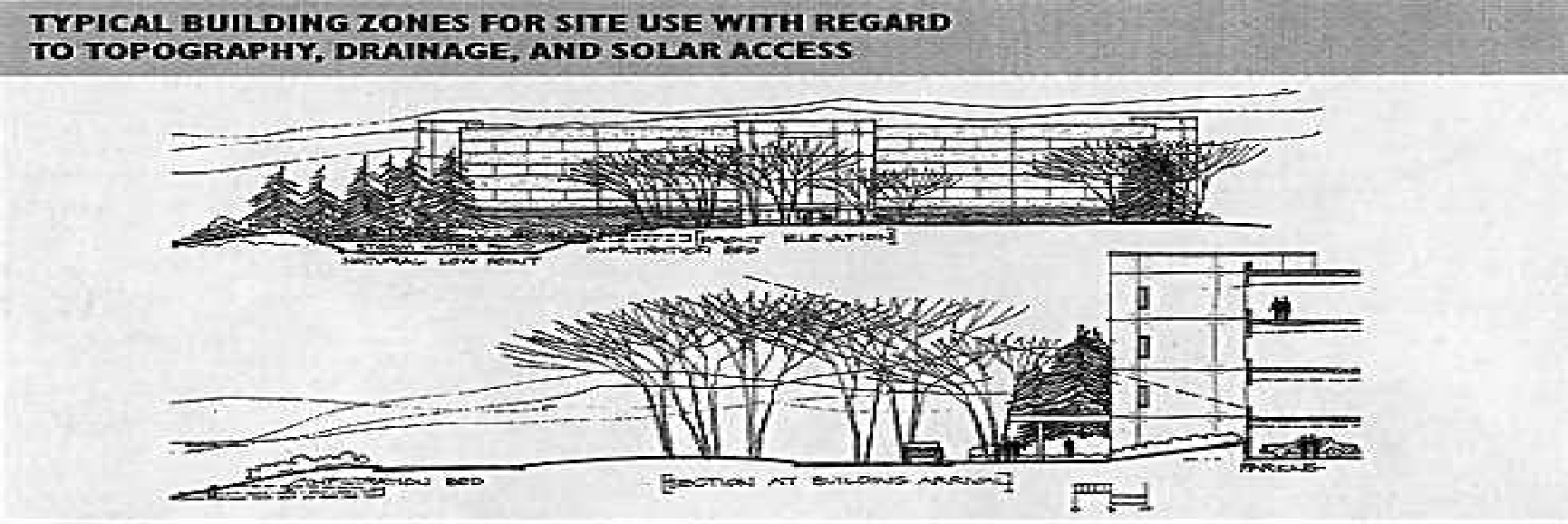
Anandarajah argues that a site analysis identifies sites for protection, sites that may lay emphasis on mitigation by evaluating site data which is categorized in order of importance (170). The soils structure, strength, and other mechanical and chemical properties are identified in the process. In addition to that, soils are classified against their properties and appropriate design with appropriate construction methods identified and incorporated in the construction process (Anandarajah, 171).
It’s worth surveying the relation of some mechanical properties of soils found at different construction sites to the construction of these buildings. According to Hooke’s law, a linear stress strain relationship exists between soil particles and compression forces to a certain extent beyond which the stiffness and strength of the soil fails to obey Hooke’s law. Therefore, the soil exhibits a non linear property in the construction of pile foundations. However, the stiffness property is improved by additional weight exerted at the bottom layers of the soil profile. On the other hand, the shear stress of soil mass acquires critical levels beyond which soil mass succumbs to external forces. Failures of these soil masses have led to serious environmental disasters such as the collapse of dams and other water holding reservoirs. Soils can undergo shear deformations resulting in volume changes causing soil dilatancy. Loose soils particles collapse and part easily causing soils such as sand to deform easily at the application of small weights (McHenry & Graham, 120).
Loose soil creeps easily under deformation forces when load is constantly or sparsely applied. Clay and peat are soil types that creep under the application of deformational forces with time. On the other hand, sand and rocks do not exhibit any creep properties and do not deform under the application of deformational forces. When water is present in porous soils, the creep property and stress transmissions are influenced by the presence of water. Varying the water levels underground proportionally varies the stress factors in the soil (Crosbie, 1).
The design and construction of a green building should be on known soils stresses at the construction site, as an additional geological factor. Data obtained at the initial stage of the survey is important in determining the behavior of the soil when subjected to additional loads and other deformational forces. Overlaying soil layers provide reliable data on vertical stresses. To Anandarajah, analytically, vertical stress, stiffness, and strength appreciably vary as the depth of the soil layer increases while lateral stress significantly remains the same (168).
In addition to the above analysis, chemical compositions, and grain size of the soil particles where the green house is proposed to be erected should be studied in detail. Sustainable constructions demand that construction materials be optimally used. One optimizing solution is to construct a green house on chemically analyzed soil to identify appropriate materials for the construction, minimizing on wastes that arise through the use of inappropriate construction materials. Chemical compositions also provide data that distinguishes different soil and rock types and the type of material to be used in the construction. The chemical properties of these soils determine the forces that lie between soil particles and forces that act on them and their behavior to these forces ( Anandarajah, 172).
To determine the ease of moving soils with existing technologies, the relationship, ß = Ww/Wk is used to calculate the consistency limits whose value has a significant relationship with the amount of water in the soil and the resistance to movement. When soil attains a specific atterberg limit (consistence limit), the effort and cost of moving the soil varies accordingly. Anandarajah notes that consistence limit influences the plasticity of soil defined by the relationship here shown: PI = wL − wP (172).The difference in the two values provides the plastic value and the ease with which the spoil movement takes place. A higher plastic value indicates significantly less energy demands than a low plastic value. Other engineering factors to incorporate in the design include the porosity of the soil, soil density, and volumetric weight defined by the relation µ= W/V = Sn_wg + (1 − n) _pg, derived from the relation W = [Sn_wg + (1 − n) _pg] V.
Materials and their specifications
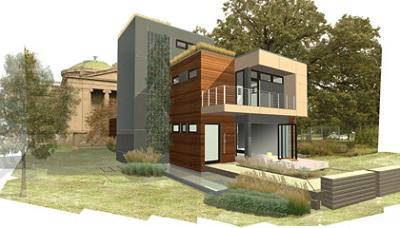
Guillette notes that focusing on the principles of sustainability that emphasizes on reduced energy consumption, environmental quality, optimal use of resources and minimal depletion, economical usage, and optimal health environment, material usage in the construction of sustainable green buildings calls for standardized approach to their acquisition and definition of inherent material properties (1).
Jo, Katsumi, Benson and Edil emphasize that materials selection strategy should incorporate the goal of economical usage and transportation as optimal components in their acquisition process (628). It is worth noting materials transportation, manufacturing, and usage leads to exponential energy consumptions at every stage of each process. Both economic performance and material costs should therefore be balanced and adhere to established standards. To ensure adherence and desirable benefits in the acquisition process, a multi disciplinary approach and life cycle assessment in the extraction and manufacture of building materials from target raw materials, and critical assessments of these materials is vital. The Life cycle assessment element should incorporate integrity and be guided on the principles of avoidance of false precisions, appropriate scale of the impact of these activities, and minimal reliance on assumptions and uncertainties.

Precision is a concept derived from the environmental impact of construction materials, such as sulphur dioxide, carbon dioxide, and other gaseous emissions. Their emissions should be within agreeable limits. In addition to that, the life cycle of building materials should characterize sustainable materials with minimal impact on the environment. Material inventory should show sustainability in their usage for the entire lifecycle of the material as illustrated above (Heinonen, Tapscott Wildin & Beall, 100).
Construction process
Mazza argues that the construction process should incorporate methods that emphasize on minimal site disruptions such as blasting and resource disruptions such as degrading ground water systems (50). On the other hand, a strategy should be incorporated that focuses on harnessing natural resources such as solar power and adequate ventilation systems creating a sustainably congenial microclimate. It is necessary for construction to be sequentially ordered (Mehnert, 2).
In the construction process, measures implemented at various levels optimize resource utilization, mitigate on incurred costs, and positively impress revenue returns on investment costs while appreciating the impact of the green building on the environment. The process incorporates measures to ensure minimal usage of water at construction sites, installation of internal systems that optimize energy usage such as lighting systems, and strategies for minimal site clearance and landscaping costs. Minimal hauling, landfills should be emphasized in the construction process to ensure consistence with sustainable use of materials with a special emphasis on usage of recycled materials (McHenry, 1).
In the construction process, feasible use and reuse or resale of construction materials should be emphasized upon to optimize all materials resulting in minimal losses and impact on the environment. Construction materials should therefore be characterized by embodied energy reductions, recyclable content, waste reduction strategies, prevention strategies that are particularly driven by the law of demand and supply (McCray, 25).
Maintenance
A closed loop technical approach in all biological and mechanical cycles is integrated to optimize energy savings and waste disposal within the system. Business profitability is maintained through cost benefits and other long term projections which are likely to generate more revenue to the home owner. The design should incorporate features that target maintenance flexibility for these buildings for future generations while mitigating on impacts on the environment particularly on energy sources (Mehnert, 1).
Conclusion
The exponential demands on energy sources by the ever rising global population and other environmental demands lays severe penalties on the consumption of energy and other resources demanding a holistic approach in their sustainable exploitation and use. Therefore, the concept of sustainability principally drives the focus on reusability and sustainability by home owners and architects in the design and construction of sustainable green houses. These houses incorporate various features that lead to optimal use and reuse of energy emphasizing on naturally occurring energy with the potential to exploit it. Macro and micro economic factors facilitate the use of naturally occurring materials incorporating the concept of reuse and recycling to optimize these resources. Therefore, the design, construction, maintenance, and other related issues should focus on sustainability and sustainable green buildings should incorporate every feature that defines sustainability. Perhaps it is vital for systems that factor efficient usage of water as a minimal resource.
References
Alexander, Christopher, Sara Ishikawa; Murray Silverstein. A Pattern Language: Towns • Buildings • Construction. NC 27513, Oxford University Press.1977
Allan, M. L, Philippacopoulos, A. J. Ground water protection issues with geothermal heat pumps. Geothermal Resour Coun Trans 1999; 23:101–5.
Anandarajah, A. Mechanism controlling permeability changes in clays due to changes in pore fluids. J Geotech Geoenviron Eng 2003; 129(2):163–72.
Bolin, Rob, PE. Sustainability of the Building Envelope. 2009. Web.
Boros, Phyllis. Going ‘Green’ Explored at SHU Gallery. Connecticut Post, 2010
Crosbie, Michael. Yale’s Green Ark, Architecture Week, 2010
Cara Baruzzi, “Kicking Off Before the Big Game,” New Haven Register, 2009
Guillette, Anne. Achieving Sustainable Site Design through Low Impact Development Practices. 2010. Web.
Hart, Kelly. Thirteen Principles of Sustainable Architecture. Building Today for Tomorrow. 2001. Web.
Horman, Michael. Journal of Green Building.College publishing. Glen Allen. 2006.
Heinonen, E.W, Tapscott R.E, Wildin, M.W, Beall, A.N. Assessment of anti-freeze solutions for ground-sourceheat pumps systems. New Mexico Engineering Research Institute NMERI 96/15/32580; 1996. p.88-200.
Jo. H.Y, Katsumi, T, Benson, C.H, Edil, T.B. Hydraulic conductivity and swelling of nonprehydrated GCLs permeated with single-species salt solutions. J Geotech Geoenviron Eng 2001;127(7):557–67.
Kirk, Stephen, J & Alphonse, J. Dell’Isola.Life Cycle Costing for Design Professionals, New York: McGraw-Hill, 1981
Mazza, Ronald. Sustainable Design Has Changed Building Design. Journal of Green Building.Toronto, Canada. 2. 3 (n.d). Web.
Mehnert, Edward. The Environmental Effects of Ground-Source Heat Pumps–A Preliminary Overview. 2004. Web.
McCray, K.B. Guidelines for the construction of vertical boreholes for closed loop heat pump systems. Westerville, OH: National Ground Water Association; 1997. p. 43.
McHenry, Paul, Graham, Jr., Adobe and Rammed Earth Buildings: Design and Construction, New York: John Wiley, 1984.
Philappacopoulus, A.J, Berndt, M.L. Influence of rebounding in ground heat exchangers used with geothermal heat pumps. Geothermic 2001;30(5):527–45.
U.S. Department of Energy. Building Energy Tools Directory. Washington. Washington.2008.156.
Vickers, Amy. Handbook of Water Use and Conservation: Homes, Landscapes, Businesses, Industries, Farms. Amherst, MA 01004-2475. WaterPlow Press.2001